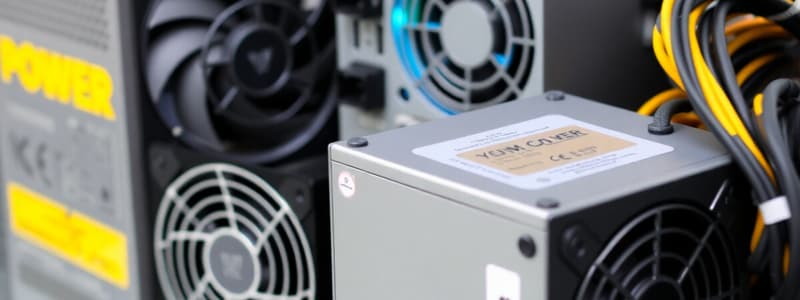Podcast
Questions and Answers
What is the primary function of a power supply unit (PSU) in a PC?
What is the primary function of a power supply unit (PSU) in a PC?
- To manage network connections
- To store data for the computer system
- To convert AC from a wall outlet into DC for computer use (correct)
- To cool down the internal components
Which type of power supply is most commonly used in desktop PCs?
Which type of power supply is most commonly used in desktop PCs?
- Flex ATX Power Supplies
- SFX Power Supplies
- Redundant Power Supplies
- ATX Power Supplies (correct)
What distinguishes modular power supplies from non-modular ones?
What distinguishes modular power supplies from non-modular ones?
- Non-modular PSUs have permanently attached cables (correct)
- Modular PSUs are more expensive than all non-modular types
- Non-modular PSUs provide better airflow
- Modular PSUs are larger in size
Which type of power supply is designed for compact or proprietary systems?
Which type of power supply is designed for compact or proprietary systems?
What key component of a PSU steps down high-voltage AC to a lower voltage?
What key component of a PSU steps down high-voltage AC to a lower voltage?
What is a common feature of redundant power supplies?
What is a common feature of redundant power supplies?
What advantage do SFX power supplies have over standard ATX models?
What advantage do SFX power supplies have over standard ATX models?
Why might someone choose a modular PSU over a non-modular PSU?
Why might someone choose a modular PSU over a non-modular PSU?
What is the primary purpose of rectifier and filter capacitors in a power supply unit (PSU)?
What is the primary purpose of rectifier and filter capacitors in a power supply unit (PSU)?
Which of the following ratings indicates the total power a PSU can supply?
Which of the following ratings indicates the total power a PSU can supply?
What function do cooling components serve in a PSU?
What function do cooling components serve in a PSU?
Which protection circuit is responsible for preventing damage from excessive voltage?
Which protection circuit is responsible for preventing damage from excessive voltage?
What is the minimum efficiency for a PSU to receive an 80 PLUS standard certification?
What is the minimum efficiency for a PSU to receive an 80 PLUS standard certification?
Which connector is primarily used to power a modern motherboard?
Which connector is primarily used to power a modern motherboard?
What role do rails play in a PSU?
What role do rails play in a PSU?
Which efficiency rating tier requires at least 90% efficiency?
Which efficiency rating tier requires at least 90% efficiency?
What does Over-Current Protection (OCP) do in a PSU?
What does Over-Current Protection (OCP) do in a PSU?
How do SATA power connectors function in a PSU?
How do SATA power connectors function in a PSU?
Which of the following features is NOT typically found in a high-quality PSU?
Which of the following features is NOT typically found in a high-quality PSU?
What is the main function of filter capacitors in a PSU?
What is the main function of filter capacitors in a PSU?
What can happen if a PSU fails to supply adequate wattage?
What can happen if a PSU fails to supply adequate wattage?
Flashcards are hidden until you start studying
Study Notes
PC Power Supply Types
-
ATX: Most common type, designed for desktop PCs, follows ATX12V standard, includes 24-pin motherboard connector, CPU and graphics power connectors.
-
SFX: Compact version of ATX power supply, ideal for mini-ITX PCs, smaller but still capable of high power output.
-
TFX: Designed for very slim desktop systems, long and narrow shape suitable for compact or proprietary PCs.
-
Flex ATX: Smaller than standard ATX, still follows ATX12V standards, used in compact PCs, servers and NAS devices.
-
Redundant PSUs: Used in server environments, offer multiple independent units, ensuring power supply even if one PSU fails.
-
Modular PSUs: Allow users to connect only necessary cables, improve airflow and cable management.
-
Non-Modular PSUs: All cables permanently attached, tend to be cheaper but creates clutter.
Key PSU Components
-
Transformer: Steps down high-voltage AC to lower DC voltage for PC components.
-
Rectifier and Filter Capacitors: Rectifier converts AC to DC, filter capacitors smooth out the DC current ensuring stability.
-
Voltage Regulators: Regulate output voltage to ensure correct voltage levels for components, preventing overvoltage or undervoltage.
-
Cooling Components: Fans expel hot air to maintain safe temperature, high-end PSUs may be fanless or have hybrid modes.
-
Protection Circuits: Include OVP, UVP, OCP, SCP, protecting the PC from electrical damage.
Power Ratings and Specifications
-
Wattage: Total power output PSU can supply, essential for component compatibility.
-
Efficiency Ratings: PSU efficiency measured in % conversion of AC to DC.
-
80 PLUS Certification: Widely recognized standard for PSU efficiency, tiered based on efficiency levels, with Standard, Bronze, Silver, Gold, Platinum, and Titanium tiers.
-
Rails and Amperage: Separate pathways for different voltages, +12V rail is crucial for CPU, GPU, and other components. Amperage on the +12V rail is important for power-hungry GPUs.
PSU Connectors
-
24-Pin ATX connector: Main power connector for motherboard, replacing the older 20-pin connector.
-
8-Pin EPS (CPU Power Connector): Delivers power to the CPU via the motherboard, may come as 4+4-pin for older systems.
-
PCIe Power Connectors: 6-pin and 8-pin connectors supply additional power to graphics cards.
-
SATA Power Connectors: Power storage devices like SSDs and HDDs, replacing older Molex connectors.
-
Molex Connectors: Older type still found in some systems, powering older hardware like fans or optical drives.
-
Peripheral Connectors: Designed for case fans, liquid cooling pumps, and other peripherals.
Safety and Protection Features
-
Over-Voltage Protection (OVP): Prevents excessive voltage to components.
-
Under-Voltage Protection (UVP): Ensures adequate voltage to prevent system instability.
-
Over-Power Protection (OPP): Shuts down PSU if it draws more power than it can safely supply.
-
Over-Current Protection (OCP): Monitors current flow to each rail and shuts down PSU if exceeding limits.
-
Short Circuit Protection (SCP): Protects against short circuits, instantly shutting down PSU in case of contact.
-
Over-Temperature Protection (OTP): Monitors internal PSU temperature and shuts down if it exceeds a safe threshold.
Studying That Suits You
Use AI to generate personalized quizzes and flashcards to suit your learning preferences.




